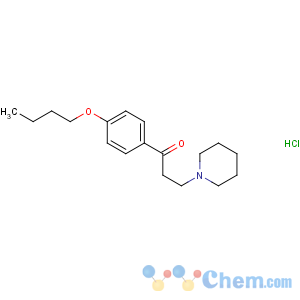Dyclonine hydrochloride
-

Molecular Structure
Detailed Description
Basic Info.
Model NO.:CAS: 536-43-6CAS:536-43-6Einecs Number:208-633-6Formula:C18h28clno2MW:325.8734Boiling Point:424.5 ° C at 760 MmhgFlash Point:210.5 ° CVapor Pressure:2.06e-07mmhg at 25 ° CAssay:99.72%Appearance:White PowderUses:for Topical AnesthesiaExport Markets:Global
Additional Info.
Trademark:YIJINGPacking:According to Every Customers′s RequirementsStandard:SGS GMP ISOOrigin:ShanghaiHS Code:2616900009Production Capacity:5000kg/MonthProduct Description
Dyclonine hydrochloride
English Name: Dyclonine, Hydrochloride; 4-butoxy-3-piperidinopropiophenone hydrochloride; Dyclonine HCL
CAS: 536-43-6
EINECS Number: 208-633-6
Formula: C18H28ClNO2
MW: 325.8734
Boiling point: 424.5 ° C at 760 mmHg
Flash Point: 210.5 ° C
Vapor Pressure: 2.06E-07mmHg at 25 ° C
Assay:99.72%
Appearance:white powder
Uses:For topical anesthesia
Description:
Dyclonine is an oral anaesthetic that is the active ingredient of Sucrets, an over the counter throat lozenge. It is also found in some varieties of the Cepacol sore throat spray. It is a local anesthetic, used topically as the hydrochloride salt.
Dyclonine hydrochloride has been found to possess, in addition to its topical anesthetic properties, significant bactericidal and fungicidal activity. Self-sterilizing action manifested by preparations containing the drug was considerably enhanced upon the addition of chlorobutanol.
Results of in vitro tests employing microorganisms commonly involved in local infections indicated that the two agents in combination act synergistically

- Dyclonine hydrochloride




